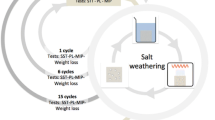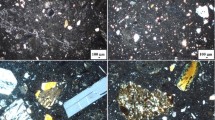Abstract
Volcanic rocks cropping out in the north-northeast of Afyonkarahisar (Turkey) are extensively used as building stones for the construction of historical buildings with structural and architectonic purposes. Three building stones, including two tuffs and an andesite, were examined in the current research. The scope of this article was to study the decay mechanisms of these porous building stones by salt. For this purpose, laboratory studies were carried out in two stages. First, the main characterization analysis of the tested building stones was performed. The main technical values and parameters such as mineralogical–petrographic (polarizing microscope, XRD and SEM), chemical (XRF) and mechanical–physical properties were studied. Moreover, this study also included pore size distribution and capillary water absorption of the building stones, while their durability was investigated by means of salt crystallization tests according to TS EN 12370. Weathering tests were carried out by applying immersion–drying cycles with water containing sodium sulfate or sodium chloride. The structural changes of the building stones after the salt crystallization tests were investigated by SEM observations and ultrasonic wave measurements, while the strength properties were determined by uniaxial compressive strength tests. The highest values of dry weight loss were observed in the Ayazini tuff sample and andesite whereas the Seydiler tuff had the lowest value. The uniaxial compressive strength was 16.37% lower in the weathered samples (sodium sulfate test) compared to the fresh samples of andesite. As a result, only the Ayazini tuff was not durable and deteriorated in the environment containing sodium sulfate.


















Similar content being viewed by others
References
Alm D, Brix S, Kjærgaard HH, Hansen KK, Grelk B (2008) Determination of resistance to salt crystallization on natural stone measured with ultrasonic wave. In salt weathering on buildings and stone sculptures. Kgs. Lyngby, Denmark: Technical University of Denmark, Department of Civil Engineering, pp. 159–167
Angeli M, Bigas JP, Menendez B, Hébert R, David C (2006) Influence of capillary properties and evaporation on salt weathering of sedimentary rocks. In: Fort R, Alvarez de Buergo M, Gomez-Heras M, Vazquez-Calvo C (eds) heritage, weathering and conservation. Taylor & Francis/Balkema, Leiden, the Netherlands, pp 253–259
Angeli M, Benavente D, Bigas JP, Menendez B, Hebert R, David C (2008) Modification of the porous network by salt crystallization in experimentally weathered sedimentary stones. Mater Struct 41:1091–1108
Angeli M, Hébert R, Menéndez B, David C, Bigas JP (2010) Influence of temperature and salt concentration on the salt weathering of a sedimentary stone with sodium sulfate. Eng Geol 115:193–199
Barbera G, Barone G, Mazzoleni P, Scandurra A (2012) Laboratory measurement of ultrasound velocity during accelerated aging tests: implication for the determination of limestone durability. Constr Build Mater 36:977–983
Beck K, Al-Mukhtar M (2010) Evaluation of the compatibility of building limestones from salt crystallization experiments. In: Přikryl R, Török a (eds), natural stone resources for historical monuments. Geol Soc Lond Spec Publ 333:111–118
Benavente D, Garcia Del Cura MA, Bernabe UA, Ordonez S (2001) Quantification of salt weathering in porous stones using an experimental continuous partial immersion method. Eng Geol 59:313–325
Benavente D, Garcia Del Cura MA, Fort R, Ordonez S (2004) Durability estimation of porous building stones from pore structure and strength. Eng Geol 74:113–127
Charola AE, Weber J (1992) The hydration-dehydration mechanism of sodium sulfate. In: Rodrigues JD, Henriquez F, Jeremias JT (eds) 7th international congress on deterioration and conservation of stone. Laboratorio Nacional de Engenharia Civil, Lisbon, pp 581–590
Clifton JR (1980) Stone consolidating materials - a status report. US Dep Commer Nat Bur Stand, NBS Tech Note 1118:46
Coussy O (2006) Deformation and stress from in-pore drying-induced crystallization of salt. J Mech Phys Solids 54:1517–1547
Delgado JMPQ, Guimarães AS, de Freitas VP, Antepara I, Kočí V, Černý R (2016) Salt damage and rising damp treatment in building structures, Adv Mater Sci Eng 2016, Article ID 1280894
Derluyn H, Poupeleer AS, Van Gemert D, Carmeliet J (2008) Salt crystallization in hydrophobic porous materials. Hydrophobe V. 5th international conference on water repellent treatment of building materials Aedificatio publishers, 97-106
Derluyn H, Moonen P, Carmeliet J, Carmeliet J (2014) Deformation and damage due to drying-induced salt crystallization in porous limestone. J Mech Phys Solids 63(1):242–255
Doehne E (1994) In situ dynamics of sodium sulfate hydration and dehydration in stone pores: observations at high magnification using the environmental scanning electron microscope. Fassina, O. A. Z., editor, International Conference on the conservation of monuments in the Mediterranean Basin, Venice, pp. 143-150
Doornkamp JC, Ibrahim HAM (1990) Salt weathering. Prog Phys Geogr 14:335–348
Espinosa Marzal RM, Scherer GW (2008) Crystallization of sodium sulfate salt in limestone. Environ Geol 56:605–621
Flatt RJ (2002) Salt damage in porous materials: how high supersaturations are generated. J Cryst Growth 242:435–454
Ghobadi MH, Babazadeh R, Khodabakhsh S (2014) Petrophysical and durability tests on sandstones for the evaluation of their quality as building stones using analytical hierarchy process (AHP). J Geope 4(1):25–43
Gonçalves TD, Brito V (2014) Alteration kinetics of natural stones due to sodium sulfate crystallization: can reality match experimental simulations? Environ Earth Sci 72:1789–1799
Goudie AS, Parker AG (1998) Experimental simulation of rapid rock blocks disintegration by sodium chloride in a foggy coastal desert. J Arid Environ 40:347–355
Goudie AS (1993) Salt weathering simulation using a single immersion technique. Earth Surf Process Landf 18:368–376
Goudie AS, Viles HA (1995) The nature and pattern of debris liberation by salt weathering: a laboratory study. Earth Surf Process Landf 20:437–449
Goudie AS (1999) Experimental salt weathering of limestone in relation to rock properties. Earth Surf Process Landf 24:715–724
Graue B, Siegesmund S, Middendorf B (2011) Quality assessment of replacement stones for the cologne cathedral: mineralogical and petrophysical requirements. Environ Earth Sci 63:1799–1822
Jefferson DP (1993) Building stone: the geological dimension. Q J Eng Geol Hydrogeol 26:305–319
Kwaad FJPM (1970) Experiments on the granular disintegration of granite by salt action. Fys Geogr en Bodemkundig Lab, Amsterdam University 16:67–80
Le Bas MJ, Streckeisen AL (1991) The IUGS systematics of igneous rocks. J Geol Soc Lond 148:825–833
Le Bas MJ, Le Maitre RW, Woolley AR (1992) The construction of the total alkali-silica chemical classification of volcanic rocks. Mineral Petrol 46:1–22
Kramar S, Mladenovič A, Kozamernik M, Mirtič B (2010) Durability evaluation of some Slovenian building limestones. RMZ-Mater Geoenviron 57(3):331–346
Martinez-Martinez J, Benavente D, Garcia del Cura MA (2011) Spatial attenuation: the most sensitive ultrasonic parameter for detecting petrographic features and decay processes in carbonate rocks. Eng Geol 119:84–95
Matovic V, Eric S, Sreckovic-Batocanin D, Colomban P, Kremenovic A (2014) The influence of building materials on salt formation in rural environments. Environ Earth Sci 72(6):1939–1951
McMahon DJ, Sandberg P, Folliard K, Mehta PK (1992) Deterioration mechanisms of sodium sulfate. In: Rodrigues JD, Henriquez F, Jeremias JT (eds) 7th international congress on deterioration and conservation of stone. Laboratorio Nacional de Engenharia Civil, Lisbon, pp 705–714
Molina E, Cultrone G, Sebastian E, Alonso FJ (2013) Evaluation of stone durability using a combination of ultrasound, mechanical and accelerated aging tests. J Geophys Eng 10:035003
Ordonez S, Fort R, Garcia del Cura MA (1997) Pore size distribution and the durability of a porous limestone. Q J Eng Geol Hydrogeol 30:221–230
Ottosen LM (2016) Electro-desalination of sulfate contaminated carbonaceous sandstone – risk for salt induced decay during the process. In J.J. Hughes, and T. Howind (Eds.), science and art: a future for stone: Proceedings of the 13th International Congress on the deterioration and conservation of stone Vol. 2, New York, pp. 897-904)
Prikryl R (2013) Durability assessment of natural stone. Q J Eng Geol Hydrogeol 46(4):377–390
Přikryl R, Lokajíček T, Svobodová J, Weishauptová Z (2003) Experimental weathering of marlstone from Přední Kopanina (Czech Republic) – historical building stone of Prague. Build Environ 38(9–10):1163–1171
Přikryl R, Přikrylová J, Racek M, Weishauptová Z, Kreislová K (2017) Decay mechanism of indoor porous Opuka stone: a case study from the main altar located in the St. Vitus cathedral, Prague (Czech Republic). Environ Earth Sci 76:290. https://doi.org/10.1007/s12665-017-6596-7
Price C, Brimblecombe P (1994) Preventing salt damage in porous materials. In: Roy A, Smith P (eds) Preprints of the contributions to the Ottawa congress, Preventive conservation – practice. Theory and Research. IIC, London, pp 90–93
Price DG (1995) Weathering and weathering processes. Q J Eng Geol 28:243–252
Rodriguez-Navarro C, Doehne E (1999) Salt weathering: influence of evaporation rate, supersaturation and crystallization pattern. Earth Surf Process Landf 24(3):191–209
Rodríguez Navarro C, Doehne E, Sebastian E (2000) How does sodium sulfate crystallize? Implications for the decay and testing of building materials. Cem Concr Res 30:1527–1534
Rodriguez-Navarro C, Linares-Fernandez L, Doehne E, Sebastian-Pardo E (2002) Effects of ferrocyanide ions on NaCl crystallization in porous stone. J Cryst Growth 243:503–516
Ruedrich J, Kirchner D, Seidel M, Siegesmund S (2005) Deterioration of natural building stones induced by salt and ice crystallization in the pore space as well as hygric expansion processes. In: Siegesmund S, auras M, Ruedrich J, Snethlage R (eds) Geowissenschafien und Denkmalpfleg. Z Dtsch Geol Ges 156(1):59–73
Ruiz-Agudo E, Mees F, Jacobs P, Rodriguez Navarro C (2007) The role of saline solution properties on porous limestone salt weathering by magnesium and sodium sulfates. Environ Geol 52:269–281
Shahidzadeh-Bonn N, Desarnaud J, Bertrand F, Chateau X, Bonn D (2010) Damage in porous media due to salt crystallization. Phys Rev E 81:066110
Scherer GW (1999) Crystallization in pores. Cem Concr Res 29:1347–1358
Sperling CHB, Cooke RU (1985) Laboratory simulation of rock weathering by salt crystallisation and hydration processes in hot, arid environments. Earth Surf Process Landf 10:541–555
Steiger M, Asmussen S (2008) Crystallization of sodium sulfate phases in porous materials: the phase diagram Na2SO4–H2O and the generation of stress. Geochim Cosmochim Acta 72:4291–4306
Stück H, Siegesmund S, Ruedrich J (2011) Weathering behaviour and construction suitability of dimension stones from the Drei Gleichen area (Thuringia, Germany). Environ Earth Sci 63:1763–1786
Trinh C, Bucea L, Ferguson O (1997) Sulfate resistance of cementitious materials mechanisms, deterioration processes, testing and influence of binder, proc. concrete 97, Adelaide, concrete Institute of Australia, pp. 263-268
TS EN 1925 (2000) Natural stone test methods-determination of water absorption coefficient by capillarity. Turkish Standards Institute, Ankara, Turkey
TS EN 1926 (2007) Natural stone test methods-determination of uniaxial compressive strength. Turkish Standards Institute, Ankara, Turkey
TS EN 1936 (2010) Natural stone test methods-determination of real density and apparent density and of total and open porosity. Turkish Standards Institute, Ankara, Turkey
TS EN 12370 (2001) Natural stone test methods-determination of resistance to salt crystallization. Turkish Standards Institute, Ankara, Turkey
TS EN 13755 (2009) Natural stone test methods-determination of water absorption at atmospheric pressure. Turkish Standards Institute, Ankara, Turkey, 10 pp
TS EN 14579 (2006) Natural stone test methods-determination of sound speed propagation. Turkish Standards Institute, Ankara, Turkey
Tsui N, Flatt RJ, Scherer GW (2003) Crystallization damage by sodium sulfate. J Cult Herit 4:109–115
Vázquez MA, Galán E, Ortiz P, Ortiz R (2013) Digital image analysis and EDX SEM as combined techniques to evaluate salt damp on walls. Constr Build Mater 45:95–105
Yu S, Oguchi CT (2010) Is sodium sulfate invariably effective in destroying any type of rock? In: Prikryl R, Torok a. (eds) natural stone resources for historical monuments. Geol Soc Lond Spec Publ, 333:43–58
Author information
Authors and Affiliations
Corresponding author
Rights and permissions
About this article
Cite this article
Çelik, M.Y., Aygün, A. The effect of salt crystallization on degradation of volcanic building stones by sodium sulfates and sodium chlorides. Bull Eng Geol Environ 78, 3509–3529 (2019). https://doi.org/10.1007/s10064-018-1354-y
Received:
Accepted:
Published:
Issue Date:
DOI: https://doi.org/10.1007/s10064-018-1354-y




